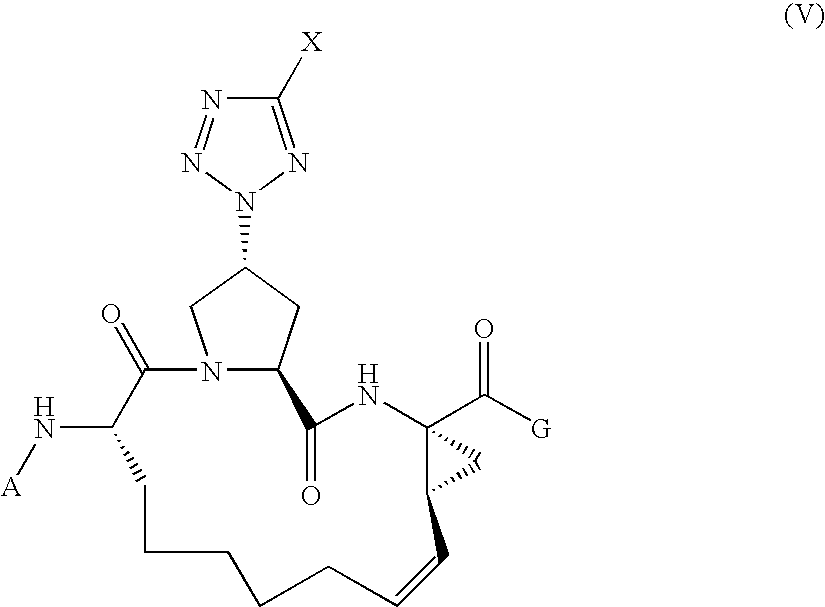Tetrazolyl macrocyclic hepatitis c serine protease inhibitors
a hepatitis c serine protease inhibitor and tetrazolyl macrocyclic technology, applied in the direction of antibacterial agents, drug compositions, peptide/protein ingredients, etc., can solve the problems of interferon-related side effects, inability to reproduce infectious culture systems and small-animal models for hcv, and increasing public health problems
- Summary
- Abstract
- Description
- Claims
- Application Information
AI Technical Summary
Benefits of technology
Problems solved by technology
Method used
Image
Examples
example 1
Synthesis of the Cyclic Peptide Precursor
[0252]
[0253]1A. To a solution of Boc-L-2-amino-8-nonenoic acid 1a (1.36 g, 5 mol) and the commercially available cis-L-hydroxyproline methyl ester 1b (1.09 g, 6 mmol) in 15 ml DMF, was added DIEA (4 ml, 4 eq.) and HATU (4 g, 2 eq). The coupling was carried out at 0° C. over a period of 1 hour. The reaction mixture was diluted with 100 mL EtOAc, and followed by washing with 5% citric acid 2×20 ml, water 2×20 ml, 1M NaHCO3 4×20 ml and brine 2×10 ml, respectively. The organic phase was dried over anhydrous Na2SO4 and then was evaporated, affording the dipeptide 1c (1.91 g, 95.8%) that was identified by HPLC (Retention time=8.9 min, 30-70%, 90% B), and MS (found 421.37, M+Na+).
[0254]1B. The dipeptide 1c (1.91 g) was dissolved in 15 mL of dioxane and 15 mL of 1 N LiOH aqueous solution and the hydrolysis reaction was carried out at RT for 4 hours. The reaction mixture was acidified by 5% citric acid and extracted with 100 mL EtOAc, and followed by ...
example 2
Synthesis of the Cyclic Peptide Precursor Mesylate
[0257]
[0258]2A. To a solution of the macrocyclic peptide precursor 1 (500 mg, 1.01 mmol) and DIEA (0.4 ml, 2 mmol) in 2.0 ml DCM, mesylate chloride (0.1 ml) was added slowly at 0° C. where the reaction was kept for 3 hours. 30 mL EtOAc was then added and followed by washing with 5% citric acid 2×10 ml, water 2×10 ml, 1M NaHCO3 2×10 ml and brine 2×10 ml, respectively. The organic phase was dried over anhydrous Na2SO4 and evaporated, yielding the title compound mesylate that was used for next step synthesis without need for further purification.
example 3
Tetrazole Synthesis
[0259]Structurally diverse tetrazoles IIIa-IIIq, for use in preparing tetrazolyl macrocycles of the invention were synthesized from commercially available nitrile compounds as described below:
[0260]To a sealed tube containing 5 ml xylene, was added 3-C1-4-hydroxy-benzoacetonitile (0.31 g, 5 mol), NaN3 (0.65 g, 10 mmol) and the triethylamine hydrochloride (0.52 g, 3 mmol). The mixture was stirred vigorously at 140° C. over a period of 20-30 hours. The reaction mixture was then cooled and poured to a mixture of EtOAc (30 ml) and aqueous citric acid solution (20 mL). After washing with water 2×10 ml and brine 2×10 ml, the organic phase was dried over anhydrous Na2SO4 and was evaporated to a yellowish solid. After re-crystallization with EtOAc-hexanes, the tetrazole compound 3a was obtained in good yield (0.4 g, 86%%), high purity (>90%, by HPLC), and identified by NMR and MS (found 197.35 and 199.38, M+H+).
PUM
| Property | Measurement | Unit |
|---|---|---|
| Fraction | aaaaa | aaaaa |
| Composition | aaaaa | aaaaa |
| Inhibition | aaaaa | aaaaa |
Abstract
Description
Claims
Application Information
 Login to View More
Login to View More - R&D
- Intellectual Property
- Life Sciences
- Materials
- Tech Scout
- Unparalleled Data Quality
- Higher Quality Content
- 60% Fewer Hallucinations
Browse by: Latest US Patents, China's latest patents, Technical Efficacy Thesaurus, Application Domain, Technology Topic, Popular Technical Reports.
© 2025 PatSnap. All rights reserved.Legal|Privacy policy|Modern Slavery Act Transparency Statement|Sitemap|About US| Contact US: help@patsnap.com



